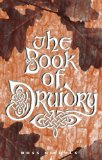
The Book of Druidry
, by Ross Nichols
Thorsons/Element, 1855381762, 320 pages (incl. bibliography, index and black-and-white illustrations), 1992
Over the years, I am sure that hundreds, if not thousands, of books have been written on the topic of Druidry. Some of them have been scholarly, some have been fanciful, and most of them have been written by outsiders. Factual history of the movement is hard to find, for a number of reasons. In the early days there was a reluctance to commit the teachings to writing. Once some of the teachings began to be written down, they were condemned and destroyed by the dominant religion (Christianity). For the safety of its members it disappeared from the sight of the common man. It continued underground, as have many persecuted minorities.
This book has one major advantage over many of those other books. It has been written by a Chosen Chief of the Order of Bards, Ovates and Druids (OBOD). While he acknowledges the lack of historical data from the earliest times (“…the gaps are larger than the area covered by what is known.”), he has the advantage of access to what records do exist. He makes no claim to an uninterrupted lineage. In the past two hundred plus years, there have been numerous manifestations of the Druidic movement – from the OBOD, the Ancient Druid Order, the Secular Order of Druids, the Glastonbury Order of Druids, to the ADF started in the US by Isaac Bonewits. There have been, and continue to be, differences in emphasis.
In the words of Philip Carr-Gomm (one of the editors of this book) “Ross managed to combine three books in one: a history of Druidry, a guide to certain ancient sites, and an anthology of Druid wisdom.” It was certainly a necessity when it was written (1975) and it still is. It serves as a counterpoint to much of the romanticized nonsense written on the topic. It is thoughtful, considerate of varying opinions, and presented in a manner which is both educational and interesting.
The author perceives Druidry as a philosophy as opposed to a religion, which may offend some readers. Nonetheless, this is an important work on the subject and deserves to be read by anyone interested in the topic. Whether you agree with the conclusions of the author, there is a great deal of information and food for thought between these covers.
More modern books tend to confine their notes; it seems to me, to the back of the book, thus necessitating a constant back-and-forth to see what the notes say. Mr. Nichols used footnotes (i.e., notes at the bottom [foot] of the page) thus doing away with this. Personally, I much prefer the footnote style, if you don’t, well there aren’t a lot of footnotes to deal with, so it shouldn’t be too large a problem.
The Bibliography and Index are both short (three and five pages, respectively). While some of the referenced works may be hard to locate, most of them should be accessible through any reasonably large library or on interlibrary loan.
In all honesty, I almost didn’t order this book, as I wasn’t sure if I wanted to tackle the subject – since so much has been written on it in recent years. It was who the author was that decided me. I am grateful now that I did request it. It is informative without boring, and it is a fairly enjoyable read. If you are looking for a good book to read about Druids as they probably were, this is the book for you.








